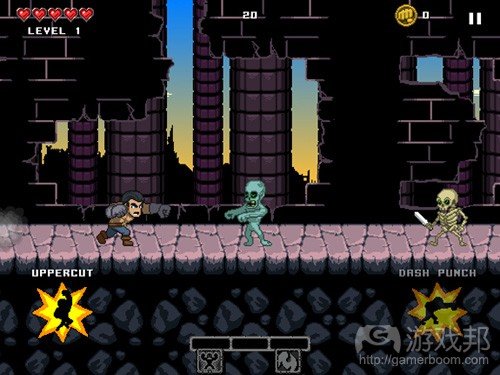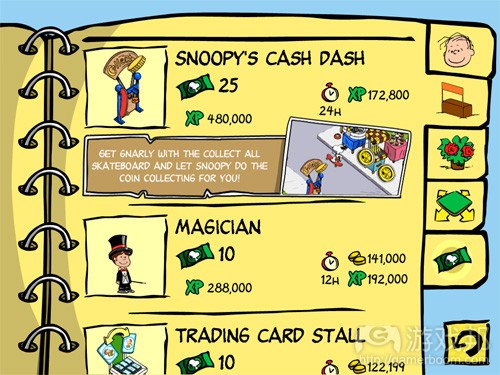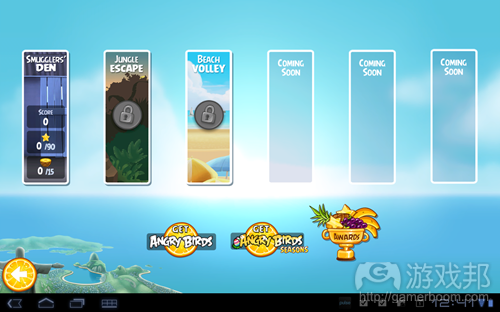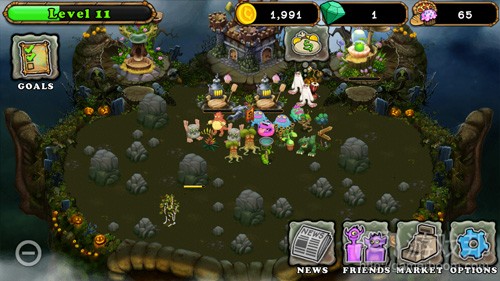列举游戏提高玩家留存率的10种途径
作者:Mickey Blumental
很久很久以前,在iOS与Android系统还未问世前,手机游戏尚未成型。
8年前,手机游戏还是新兴市场,当时我特别希望全球最大型的游戏开发商能涉入移动设备,制作出拥有极高人气的作品。无论是《生化危机》、《急速快感》、《最终幻想》、《Project Gotham Racing》还是《模拟人生》,各种游戏题材将会面临全新的设计挑战。
回想那时,几乎所有手机游戏都是热门主机与PC游戏的粗劣仿制品。手机性能尚不完整,笨拙按钮并不是理想控制器。鉴于此,我们制作了一些在当时可堪称为佳品的游戏。但如果没有考虑到这些限制条件,它们的画面确实是有失水准。
花费几美元便可体验一个半小时似乎物有所值。实际上,对于大多数玩家而言,这些游戏固然有趣,但玩过就算了。因此,最重要的是在玩家表现出“看,我手机上有《生化危机》”这种新奇感淡化之前,就要让他们能够完成整个游戏体验。
然而这些时日已经逝去。触屏设备的兴起引来出色作品。我发现自己更喜欢在iPad上玩游戏。它并不是完美游戏平台,尤其不适合模拟主机游戏体验,但作为开发人员兼玩家身份的我最喜爱这种设备。
此时,让游戏尽快招徕玩家已无多大必要。
事实上,保持玩家长时间体验游戏对玩家与开发者都有利。对玩家而言,他们会对游戏产生情感依恋,获得成就感,而后长时体验。
对开发者而言,留存用户相当重要,原因如下:
1.交叉推广与曝光。每当推出新作品或升级版本时,你可以交叉推广自己的作品,但这只对老玩家有用。
2.应用商店中的大部分收益来自应用内置购买。明智且正当的盈利方式能保证游戏能够吸引玩家长时间投入。
3.口口相传。玩家投入越长时间,他们更有可能向他人宣传游戏,为获得游戏内奖励而推荐他人体验游戏,利用博客或Twitter进行推广。
留存用户与游戏营销不应该混为一谈。前者并非指代吸引新玩家,而是留存旧玩家长时体验。借此可以促进游戏推广,但其本身不属于营销战略。比如,在电视剧中设置悬念能够保证不少观众下周继续收看,但却无法立即吸引新观众。另外,如果用户不断听到关于某电视剧的赞美,他们最后更有可能试着看看。
其实提高用户留存率有多种途径。其中最佳举措是推出优秀作品。有些游戏极具成瘾性与趣味性,它们不必引诱便能留存玩家。
然而,即使游戏不够出色,你也不必感到绝望。毕竟品质不是必要条件。实际上《Farmvile》中除了无需动脑的点击,并没有所谓的玩法,但它却能吸引大批玩家。它有点像可卡因毒瘾,只是它携带着更具突破性的社交性。
以下是提高游戏用户留存率的10种简单途径:
1.成就
成就一词来源于,通过得分收藏虚拟徽章极具沉迷性,但这却无多大意义,最多是代表胜者为王,但事实是没有哪位玩家在乎游戏得分(除了你)。而你在乎的唯一理由是你认为其他人同样在意此方面。情况恰恰相反。但是解锁成就机制仍十分有趣。也许是因为玩家们自我感觉良好。
成就可能是在游戏主要范围外,完成额外困难任务,在战斗游戏中获得诸如高组合装备,也可能是重复上万次同个动作获得刷任务的奖品。
如果取得成就难度颇大,耗时过长,玩家不久就会放弃游戏进程,也就是说即便是在深长的隧道,也应该在终点处设置一盏让玩家看到希望的明灯。正确设置成就机制能为玩家指点迷津,带领他们体验更长路径。
2.任务
任务类似成就,只是着重点不同。通常同一时间内只能激活三个任务,而在任务完成后,除了解锁新任务,游戏还会奖励玩家虚拟货币与奖励(游戏邦注:包括金币、经验值等)。无尽游戏中的任务特别有效,因为拥有三个不同活跃任务可以调整游戏重点,增添每个回合的多样性。通常该过程还伴随玩家逐渐进步,保证游戏结构化发展。
任务系统能够激励我完成《Punch Quest》、《Zombie Tsunami》、《Into the Dead》与《Jetpack Joyride》这类游戏。
3.升级
升级是人为地提高玩家精通游戏的方法。你突然获得成功,取得可观分数,但这并不一定是因为你的技能水平提升了,而有可能是因为你购买游戏内部升级道具提升了你的状态值,降低了整个游戏难度。为何要费力使用小型枪械射击鸭子,而不用追踪火箭发射器或原子弹呢?应让玩家投入大量时间刷任务以获取足以购买所有升级内容的虚拟货币。同时这也是盈利的大好商机,你可以为懒惰玩家开辟捷径,让他们利用现金便可快速获取升级内容。
升级是从角色扮演题材中提出的基本概念,而后通过调整逐渐适用于大多数休闲游戏(游戏邦注:尤其是无尽游戏)。再加上任务系统便可为玩家提供进步感与发展感,而事实上你仍在游戏不断重复同一个两分钟的循环。
有两款无尽奔跑游戏包含成瘾性升级系统,它们分别是《One Epic Knight》与《Jetpack Joyride》。
4.日常奖励
游戏应吸引玩家至少每天登陆一次。玩家下载游戏后甚至可能不会登陆并兑换奖励,但此时,我们可以曝光即将出炉的升级内容与新作,或向他们展示相关广告。但你需在这宝贵的几秒钟内抓住玩家的注意力,因此你最好深谙此道。
问题是,为玩家提供过多奖励会破坏虚拟经济,而奖励过少则是侮辱玩家智商(令人担忧的是,不少游戏会采用后者方法并侥幸获胜)。最佳方案是创建出随着连续登陆天数的增加,逐级递增的奖励模式,或者也可以向玩家提供以实物为奖品的刮刮卡,同时还能无害地满足他们的“赌瘾”。
比如《Snoppy’s Street Fair》每隔五天会奖励你一笔高级金币,但前提是要每天登陆。
5.重返游戏
为何要以奖励承诺吸引玩家回到游戏进程,而不是采用惩罚威胁?如果玩家没有定期登陆,他们的稻谷将会枯萎,宠物会痛苦死去,妻子会带着孩子离开,堡垒会遭到入侵并完全烧毁,所有厕纸都会用光。
如果游戏能够成功吸引玩家频繁访问,放弃他们的社会生活、责任与睡眠,那你将有望成为大富豪。
但你也会因此而罪孽深重。
6.定期更新
如果你让玩家养成期待定期更新的习惯,他们会相当期盼。大部分时候玩家是喜爱游戏的,但他们并不清楚开发者是否会继续推出新内容。
我们可以采取某些巧妙举措令玩家知晓新内容即将问世。比如《1000 Heroz》承诺,会在1000天内每天为玩家呈现一道新关卡,直到推出成型作品。《愤怒的小鸟里约》就有一个针对未来内容的空白占位符,让玩家对新内容有所期待。
7.季节性内容
季节性内容会令玩家喜悦,同时也会营造一种紧迫感,因为其提供的独特奖励会在假期结束后终止,而下一个奖励要等到明年。因此在短期内,玩家需要经常体验游戏,确保没有错失限时奖励。奖励通常是装扮品,
这对那些沉浸在收藏与展示虚拟道具的目标用户而言颇具价值。
千万不要忘记更新应用图标,突显节日气氛,比如使用圣诞帽或是挂上南瓜灯。孩子们也会都这样做,可见这是必要事项。
此外,体现当前假期与季节还能告知玩家目前开发团队仍在支持该游戏。但要记得在三月移除圣诞装饰,否则所有努力将会换来相反效果。
8.社区
该方面较难实现,而且应针对游戏类型特别定制。这需要大量工程,而且开发者投入的时间与精力未必能够有所回报,因此要谨慎小心。你的游戏支持玩家展示自己的创意吗?他们可以与其他玩家分享自己的锦囊妙计吗?《My Singing Monsters》邀请玩家发送唱歌的不同剪辑片段,而后组合成一个微视频。
《Carmageddeon》允许玩家录下自己碾压路人,撞上其它车辆的经过,而后直接将视频上传到Youtube上。
《Snoopy’s Street Fair》为玩家提供照相馆,在此你可以与该作中的角色合影。
其它游戏还会利用复杂玩法,创建论坛,方便玩家探讨战略,交流建议。
9.收藏品
我们应精妙设置收藏品,可以是奖励玩家的探索与投入时间,或是出现在半途中。总之,这两种情况均能提高玩家的游戏时长。
如果游戏世界颇为枯燥,设计较为粗糙,那么增加供玩家收集的收藏品只会适得其反。在《Aquaria》中寻找宝藏是件美事,因为探索这个美丽的世界本身就是件乐事。
《Crackdown》是内容大量重复,表现一般的第三人称射击游戏,而寻找魔法球的支线任务则补救了这些不足。缩放游戏环境,寻找暗示魔法球位置的相关线索是我在该游戏中曾体会到的最大乐趣。
10.重玩价值
如果你的游戏充满乐趣,玩家可能会重新体验。同时,增加更多复杂层次也能鼓励玩家重玩游戏。比如提供附加支线挑战,鼓励玩家以更高分数战胜同个挑战的奖牌系统。解锁难度更大的关卡。这种用户留存方法最具实用价值,资深玩家喜爱这种模式。但前提是游戏应足够出色与有趣,才能保证他们重返进程。
严格上说,上述的方法都无法取代推出一款佳作,毕竟市场上的劣质产品偏多。而且,上述所有留存方法并非都适合你的游戏,因此不要削足适履地硬搬这些做法。而应仔细思考,看看哪种模式对你的游戏更有意义。(本文为游戏邦/gamerboom.com编译,拒绝任何不保留版权的转载,如需转载请联系:游戏邦)
10 Ways to Retain Your Players
by Mickey Blumental
The following blog was, unless otherwise noted, independently written by a member of Gamasutra’s game development community. The thoughts and opinions expressed here are not necessarily those of Gamasutra or its parent company.
The following blog was, unless otherwise noted, independently written by a member of Gamasutra’s game development community. The thoughts and opinions expressed here are not necessarily those of Gamasutra or its parent company.
A long long time ago, before the age of iOS and Android, mobile phone games were pretty crap.
Eight years ago it was a new and growing market and I had tons of fun trying to fit some of the world’s biggest game franchises into mobile devices that were about as suitable for gaming as your average microwave. Resident Evil, Need for Speed, Final Fantasy, Project Gotham Racing, Sims – each game genre brought with it new design challenges.
Back then almost all the phone games (that made money) were malformed bastardized versions of current hit console and PC franchises. The hardware was constrained in terms of performance and the clunky phone keys weren’t the ideal game controller. Considering these limitations, we made some awesome games back in those days. But if you don’t consider those limitations (and why should you), these games were somewhat bleh.
Getting an hour and a half of gameplay for a couple of dollars seemed like good value. In fact, it was an act of mercy, as playing through those games, for the most part, was about as fun as flossing. So it was all about getting the player to finish the game before the “hey look, Resident Evil on my phone” novelty wore off.
Those days are over. Touch screen devices have amazing games. I find myself playing on the iPad more than any other platform. It’s not a perfect gaming platform, especially not for games that try to emulate console games, it’s the one I’m most excited about both as developer and gamer.
Suddenly getting your customers out the door as fast as you can is no longer necessary.
In fact, keeping players engaged with your game for longer is beneficial for both player and developer. The player develops an emotional attachment to the game and a sense of accomplishment and investment over a long period of time.
For the developer user retention is important for the following reasons:
1. Cross promotion and visibility. Your games can cross-promote each other whenever new games or updates are released, but that is only effective if people are still playing the older games.
2. Most of the revenue in the app store comes from in-app purchases. Monetize your game correctly and wisely and you would have every reason to want people to play your game for as long as possible.
3. Word of mouth. The longer players play your game, the more likely they are to tell others about the game, recruit other players for in-game rewards, blog or tweet about it.
User retention should not be confused with marketing. It’s not about getting new players, it’s about keeping the players you did get for as long as possible. One of the positive rewards is a boost in marketing, but it is not a marketing strategy in its own right. For example, having an awesome cliffhanger in a TV show is going to ensure many viewers return the next week, but it’s not going to get new viewers to tune in right away. On the other hand when people keep hearing how awesome that TV show is, they are more likely to eventually give it a chance.
There are many ways to facilitate user retention. The best one is having a good game underneath it all. Some games are so addictive and fun they don’t really need to seduce the player to stick around.
But don’t despair even if your game is terrible. Quality is not necessary. Farmville offers practically no gameplay beyond mindless clicking, but it has done a fantastic job hooking players. A bit like a crack-cocaine addiction, only it carries a more devastating social stigma.
Here are super simple ways in which you can increase your game’s user retention:
1. Achievements
Achievement whore is a term that was coined for a reason. It can become very addictive to collect these virtual badges with points that mean absolutely nothing to anyone. It’s supposedly something that is meant for bragging rights, but in fact nobody in all of existence ever, except you, cares about your gamer score. No one. In fact, the only reason you care about it is because you think others might care too. They don’t. Yet, it is still for some reason fun to unlock achievements. Perhaps it is just because people like to feel good about themselves.
Achievements can range from accomplishing extra difficult tasks beyond the main scope of the game – like getting ridiculously high combo in a fighting game, or it can simply reward tedious grinding for performing the same action 1000000 times.
If the achievements strike the player as too difficult or time consuming they are going to give up on them fairly soon, so while it should be a long tunnel, there should always be light at the end. Done correctly achievements can help draw a map for the player that takes them on a longer path through the game.
2. Missions
Missions are similar to achievements, but have a different focus. There are usually only three missions active at one time, replaced with new missions as they are beaten and they almost always reward the player with in-game currency and rewards (coins, experience points, etc.). Missions are especially effective in endless games as having three different active missions changes the focus of the game and adds variety to each session. It is usually accompanied by a progression ladder that gives the game structure it would otherwise lack.
A missions system kept me playing through games like Punch Quest, Zombie Tsunami, Into the Dead and Jetpack Joyride far longer than I would have otherwise.
3. Upgrades
Upgrades are an artificial way to make the player better at the game. Suddenly you get further and score better, but it’s not necessarily because you honed your skills to perfection as much as the fact that you bought in-game upgrades that improve your stats and overall make the game easier. Why bother trying to shoot a duck with a small gun when you can use a heat seeking rocket launcher instead? Or a nuclear bomb? The player needs to invest a significant amount of time to grind all the currency needed to buy all the upgrades. This is also a good opportunity for monetization as you can offer lazy players a shortcut and offer the upgrades faster for real world money.
Upgrading is a basic concept lifted from the Role Playing genre and tweaked to fit more casual games, especially endless games. Together with the missions system, it’s another way to offer a sense of progression and development when you’re in fact still playing the same two minutes over and over again.
Two games with very addictive upgrade systems are the endless runners One Epic Knight and Jetpack Joyride.
4. Daily Rewards
Tempt your players to log into your game at least once a day. They might not even play the game beyond loading it and claiming the rewards, but it’s a great opportunity to flash any news about upcoming updates or perhaps other games you’re about to release – or just flash obnoxious ads in their face. You grab the player’s attention for a few priceless seconds, so you had better put it to good use.
The problem with rewards is that if you give the players too much you break your virtual economy and if you give them too little you insult their intelligence (it’s worrying how many games do the latter and actually get away with it). A good solution is to create a growing reward ladder that increases every consecutive day of logging in, or alternatively offer the player a scratch card with a good chance of winning something substantial – harmlessly scratching the gambling itch at the same time.
Snoopy’s Street Fair rewards you with a generous portion of deluxe currency every five days, but only if you keep logging every day.
5. Come Back or the Puppy Dies
Why lure players back with the promise of rewards when you can do it with the threat of punishment? If the player doesn’t log in regularly their crop will wither, their pets will die an agonizing death, their wife will leave them and take the kids, their fortress will be invaded and burnt to the ground and all the toilet paper will be used up.
If your game succeeds in compelling the player to visit on an hourly basis, giving up on their social life, responsibilities and sleep, you are going to be a very rich person.
Though a lot of good all that money is going to do you in HELL.
6. Regular Updates
Once you train your players to expect regular updates, they will look forward to them. Many times players like a game, but they have no idea if the developer is still supporting it.
There are clever ways to let players know that new content is on the way. 1000 Heroz promised players a new level every day for 1000 days until the whole game was released. Angry Birds Rio had empty place holders for future content with a date on each spot telling the players when to expect it.
7. Seasonal Content
Seasonal content puts people in a festive mood, but also has a delightful sense of urgency to it as it offers unique rewards that expire when the holiday ends until the same time next year.
So for a short period of time players are urged to play your game more to ensure they don’t miss out on limited time rewards. The rewards are usually cosmetic, which doesn’t make them any less rewarding to the target audience that is obsessed with collecting and showing off their virtual items.
And don’t forget to update the app’s icon to reflect the holiday by sticking a Christmas hat or a jack-o-lantern on it. All the cool kids are doing it, so it must be the thing to do.
Reflecting current holidays and seasons also tells the player that the game is currently being supported by the development team. Just remember to remove the Christmas decorations by March or the whole thing will backfire.
8. Community
This one is a tricky one to pull off and must be tailored to the type of game you have. It can be a lot of work which does not always recoup the time and effort invested, so tread carefully. Does your game allow your players to show their creativity? Can they share their cleverness with other players? My Singing Monsters invited users to send clips of them singing different parts and then assembled it into a silly little video.
Carmageddon lets players record themselves flattening pedestrians and crashing into other cars and then upload the videos directly to Youtube.
Snoopy’s Street Fair provides you with a photo booth in which you can take pictures with Snoopy characters.
Other games capitalize on the fact that they offer complex gameplay and provide players with forums in which they can discuss strategy and exchange tips.
9 collectibles
Collectibles could be done cleverly, intelligently rewarding exploration and time investment, or they could be a half assed throwaway. In both cases it’s likely to get players to play the game a bit longer than they would otherwise.
If your game world is bland and badly designed adding collectibles for the player to collect is basically just twisting the knife. Looking for hidden treasures in Aquaria is rewarding because it is already fun to explore that beautiful world.
Crackdown is an immensely repetitive and average 3rd person shooter that is saved by a side mission to find hidden orbs. Scaling the environments in search for audio and visual hints for orb locations is some of the most fun I ever had in a videogame.
10. Replayability
If your game is fun people are likely to play through it again. This can be further encouraged by adding more layers of complexity to the game. Offer additional side challenges, offer a medal system that encourages to beat the same challenges with better scores. Unlock hidden harder levels. This is the user retention technique with the best nutritional value that veteran gamers will really appreciate. It only works if your game is good enough and fun enough to justify a return visit.
But seriously, none of these techniques are an alternative to having a good game. There are enough crap games out there. Not all of the listed user retention methods might suit your game, so don’t bend backwards like a pretzel trying to fit them in. But give it a thought and see which ones make sense for your game.
That’s it for user retention. Next week we’ll discuss water retention. (source:gamasutra)
上一篇:开发者分享《Puzzle Craft》制作经历和过程
下一篇:阐述游戏测试员的定义及其职业规划












































 闽公网安备35020302001549号
闽公网安备35020302001549号